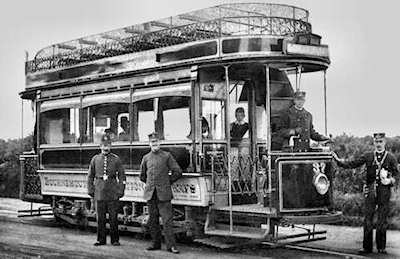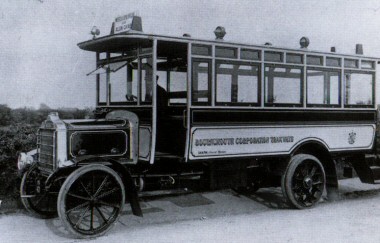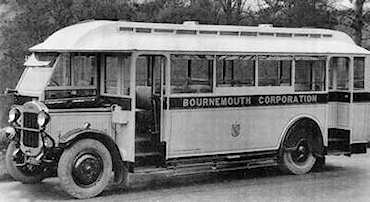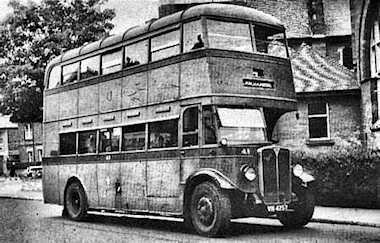|
Getting about in the past
The development of Charminster and Queens Park coincided
with the appearance of modern road transport. Electric motors
and petrol engines were taking over from horses when the newly
built suburbs around Malmesbury Park found themselves on Bournemouth's
new tram network.
Trams

Queens Park Corner, 1906 |
The first tram ran from Richmond Hill to Capstone
Road just before Christmas in 1902. The line ran up Charminster
Road, down Capstone Road and on to Holdenhurst Road. Another service
ran into town from Queens Park Corner (the junction of Ashley
and Holdenhurst Roads).
Befitting their new ultra-modern equipment, the
drivers and conductors wore smart uniforms. A reporter from the
Bournemouth Graphic wrote in 1902 that "the gorgeous apparel
of the Bournemouth Tram Car inspectors closely resembles that
of a military staff officer", and a lady had assured him
that there was "enough braid on each inspector's arm to trim
a dress for herself and another for the baby."
The trams may have been shakey, slow and noisy -
but they were reliable. You would never normally have to wait
more than a quarter of an hour to catch one.
Electric power for the trams was provided by the
Borough Council's own power station in Southcote Road where there
were four coal fired steam generators.
Plans to introduce Sunday services were vigorously
opposed by churchmen and residents who did not want their day
of rest disturbed. The matter was partially settled by a local
referendum and afternoon Sunday services were introduced in 1913.
Sunday morning trams did not appear until 1926.
The tram service was finally closed down in 1935-36
- even though trams still remain a mainstay of public transport
in various cities around the world.
Trolley buses

1935 Sunbeam trolley bus |
The rails were dug up and the trams were replaced
by trolley buses in 1935. Faster, smoother, cleaner and virtually
silent the new vehicles were seen as a big improvement. The move
also made the roads safer for cyclists who could easily be thrown
off their bikes if their wheels dropped into the tram rail slots.
The two trolley bus routes serving Charminster were
Number 28 opened in 1935 to link The Square to Castle Lane via
Charminster Rd, and the Number 2 which started two years later
between The Square and Malvern Road.
During the war years around a third of the fleet
was loaned to other cities whose transport systems had been badly
damaged by bombing.
The standard Sunbeam trolley buses seated 56 people
and had both front a rear exits with automatic doors. They were
so reliable that many of the original 100 were still operating
when Bournemouth's trolley bus network was finally closed down
in April 1969.
Buses

1914 Daimler |
Charminster got one of Bournemouth's first regular
bus services in 1914 when a route was introduced between Cemetery
Junction and Fiveways.
Two of vehicles were of a design that sounds very
modern in retrospect. The Tilling-Stevens bus combined petrol
and electric motors. The petrol engine drove a dynamo which in
turn powered an electric motor. The result was a smooth ride and
acceleration in a vehicle that had no clutch or gearbox.
The route was withdrawn at the outbreak of the First
World War, but ran again for a couple of months in 1915.
The buses were originally seen as supplementary
to the trams but their flexibility, economy and growing reliability
put them on course to finally overcome electric powered transport.
Bus routes were gradually developed in the 1920's.
1922
- Kings Road to Charminster Avenue/Gresham Road
1927
- Queens Park to Winton via Richmond Park Road
- Kings Road to Malvern Road via Ripon Road
- Charminster service extended to Castle Lane

1931 Thorneycroft |
1930
- Thorneycroft express bus service introduced to supplement
the tram route from Lansdowne to Kings Road
Bus finally got formal route numbers in 1931.
The three routes covering Charminster and Queens
Park were the Number 4 from the Square via Charminster to Castle
Lane, the Number 5 from the Square via Charminster to Malvern
Road, and the Number 7 from Boscombe via Charminster and Winton
to Columbia Road.
Wartime
On the declaration of war in 1939, all bus services
ceased at lighting up time, but within a week a restricted service
was introduced to run through the blackout. Some buses were sent
to other parts of the country - but because of petrol rationing
and the relatively small number of private cars, the war years
were very busy for public transport.
As many men were now serving in the forces, Bournemouth
got its first woman bus conductors in 1941. Around 200 of them
were subsequently trained as drivers.
The first diesel buses appeared in 1943. Because
of paint shortages they were simply finished in grey or brown.
All buses were fitted with shades over their headlights to prevent
them from being seen by enemy aircraft.
 1948 - outside the Congregational
Church in Capstone Road
1948 - outside the Congregational
Church in Capstone Road |
A number of bus services were curtailed during the
war and there were no buses after 9 PM. Sunday services started
at 1 PM except for special workers buses which also ran on Christmas
Day.
Post-war
Vehicles were replaced with both second-hand and
new buses after the war and services expanded.
The Bournemouth public transport system reached
its peak in 1950 with more passenger journeys than at any time
before or since.
But the end of petrol rationing in 1950 led to a
rapid increase in car ownership and subsequent decline in public
transport.
The last major change was the closure of the trolley-bus
system in 1969.
|